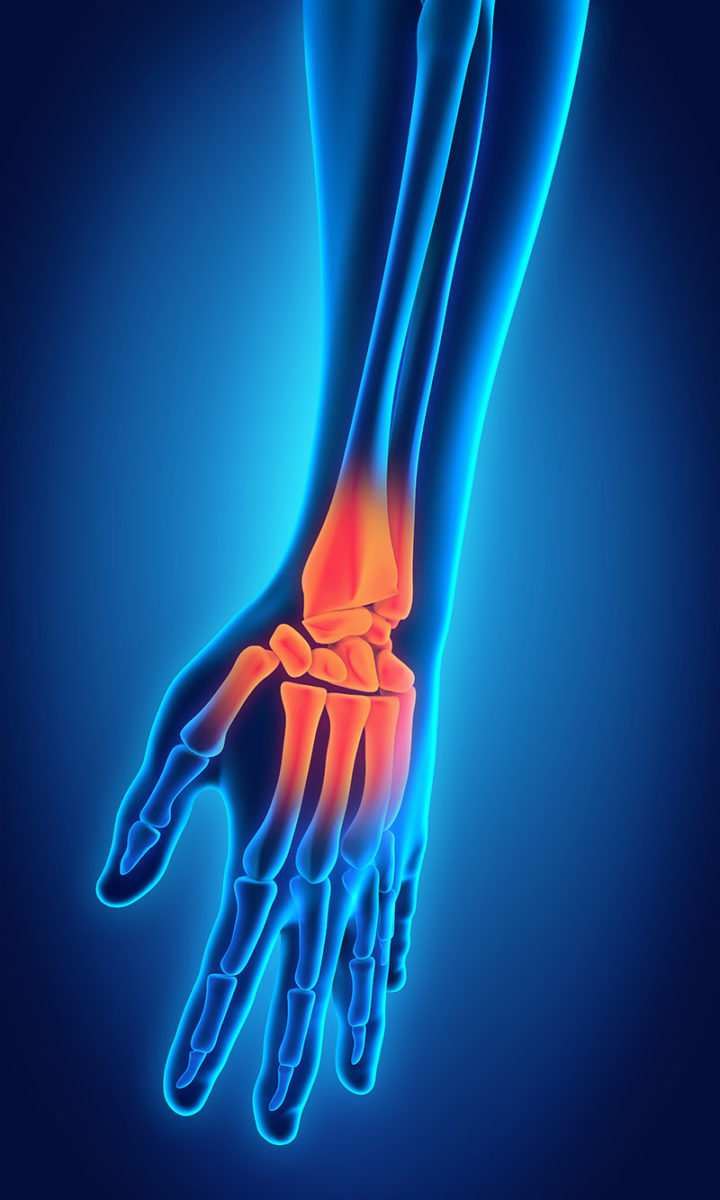TFCC Tear Treatment in Dallas & Frisco
Triangular Fibrocartilage Complex Tears

Painful triangular fibrocartilage complex rips might limit a person’s ability to utilize their hand or wrist. But what precisely is a TFCC tear? What is the treatment for this injury? Understanding what this injury is and how to recognize its symptoms will help you go back to living pain-free sooner. That’s why it’s important to consult with a Dallas orthopedic surgeon.
At SPORT Orthopedics and Physical Therapy, our orthopedic and physical therapy specialists have extensive experience in their field. We offer a variety of treatment options for an even wider variety of conditions. To schedule your appointment with us, please call 469-200-2832 or fill out our online intake form today.
What Is a TFCC Tear?
The wrist is formed by the triangular fibrocartilage complex (TFCC), which links the hand and forearm bones. Several ligaments, tendons, and cartilage make up your TFCC. When gripping something with your hand or twisting your forearm, it aids wrist movement and stabilizes the forearm. Any injury or damage to the TFCC is referred to as a TFCC tear. The two forms of TFCC tears are described here.
- Type 1: A physical damage causes these rips. When a person overextends their wrist or falls on their hand while it is outstretched, this might happen.
- Type 2: These tears develop over time and might be caused by aging or an underlying health problem such as gout or rheumatoid arthritis.
What Causes TFCC Tears?
A TFCC tear can occur in two places and is typically caused by distinct issues. Natural wear causes the first form of TFCC tear, whereas damage causes the second. Wear-related tears are the most prevalent, although they are rarely observed in younger people. As one grows older, they become more prevalent. TFCC tears and injuries come from the following.
- Falls onto the wrist or hand
- Twisting injuries, such as those that occur from a caught drill bit or anything else that twists the arm
- Radius fractures at the end of the bone

Symptoms of a TFCC Tear
Wrist pain is a typical symptom of TFCC tears. The discomfort may be persistent or present just when you apply pressure or move your wrist. The following are some of the other signs and symptoms of a TFCC tear.
- Stiffness or weakness in the wrist
- Limited range of motion in the wrist or hand
- Swelling of the wrist
- Loss of grip strength
- Popping or clicking sound as you move your wrist
Tennis players and gymnasts are at a higher risk of developing a TFCC tear because they apply strain on their wrists on a frequent basis. If you’ve previously hurt your wrist, you’re at a higher risk of a TFCC tear.
TFCC Tear Risk Factors
The wrist is one of the body’s most complicated joints. Because of this, it is prone to wrist sprains and injuries. Physical trauma, heavy usage, or the aging process can also cause TFCC tears. The following factors can enhance a person’s chance of having a TFCC tear.
- Age: As a person gets older, TFCC tears become more prevalent. This might be due to normal wear and tear, or because the body’s ability to heal TFCC damage deteriorates.
- Chronic inflammation: Inflammatory diseases like rheumatoid arthritis and gout can cause wrist damage over time. TFCC tears were observed in 38.9% of individuals with severe rheumatoid arthritis, according to a small retrospective research.
- Sports: Wrist injuries are more common among athletes that participate in sports like baseball, football, or tennis. According to research, the hand or wrist is involved in about 25% of all sports injuries, whether in a wrist fracture or otherwise.
How to Diagnose a TFCC Tear
The fovea test, also known as the ulnar fovea sign, is frequently used to identify TFCC tears. Your doctor will do this by applying pressure to the outside of your wrist and asking whether you experience any discomfort or soreness. For comparison, they’ll perform the same thing on your unaffected wrist.
You could also be requested to do a series of wrist motions. Rotating your forearm or shifting your hand away from your thumb are two examples. An X-ray may be used by your doctor to ensure that you don’t have any fractured bones in your hand or forearm.
TFCC Tear Test
Even when the patient has little or no pain, orthopedic specialists can use a variety of diagnostic techniques to evaluate the amount of damage or the extent of a tear. TFCC can be less painful than it appears, and some very advanced diagnostic procedures are used to better diagnose and treat injuries, as well as age-related wrist degeneration. Weight-bearing tests and a number of imaging techniques are among the diagnostic procedures available.
- Utilizing increasing weight loads as a metric for injury severity
- Lifting and gripping exercises to determine what you can accomplish without pain
- Visual tests including observing for swelling, discoloration, and bone placements
- MRI (magnetic resonance imaging) which allows for scans of the soft tissues
- MRA (magnetic resonance angiogram) often serves as a complement for the MRI in viewing soft tissue injuries
What Are the Treatments for a TFCC Tear?
The kind, origin, and severity of the injury determine the treatment choices for TFCC tears. A TFCC rupture will usually heal on its own. To minimize additional harm and to allow the afflicted wrist to recover correctly, a person must stop using it.
Non-Surgical Treatment
To protect and immobilize the wrist, a healthcare practitioner may prescribe wearing a splint, brace, or cast. They may also recommend pain relievers like ibuprofen or steroid injections to aid with swelling and discomfort.
Some patients with TFCC tears may benefit from physical therapy in Dallas. For the damaged wrist, a physical therapist will lead the patient through some moderate stretches, exercises, and activity modifications that seek to accomplish the following.
- Reduce swelling and pain
- Increase range of motion and improve flexibility
- Increase strength
Wrist Surgery
A doctor may prescribe surgery for patients who have severe or recurring TFCC tears. A sort of minimally invasive technique known as wrist arthroscopy is one surgical possibility.
A surgeon will make a series of tiny incisions on the outside border of the wrist during an arthroscopy to treat the damage to the TFCC. They may also shorten the ulna to help with the symptoms. Following surgery, your doctor will recommend immobilizing the wrist for up to 6 weeks.
TFCC Tear Exercises
There are various exercises you may do at home to aid the healing process when recovering from a TFCC tear. The following are some exercises we recommend.
- Move your wrist in circular motions, both clockwise and counterclockwise.
- Stretch the wrist back toward the forearm. Then stretch it forward in the opposite direction.
- Flex the wrist against a hard surface.
- Repeatedly grip a tennis ball.
To prevent overexerting your wrist, start by doing only a few of these exercises at a time. Stop doing any of the motions if they cause significant discomfort. Depending on your health, your doctor can also go through some safe home workouts with you.
How Long Is the Recovery Time After a TFCC Tear?
Recovery time for TFCC tears that do not require surgery is generally four to six weeks. If surgery is required, it might take anywhere from six weeks to several months to restore full wrist function. Physical therapy and avoiding activities that put a pressure on your wrist might help you heal faster.
What Is the Outlook for Someone with a TFCC Tear?
While most individuals heal completely from a TFCC rupture with physical therapy or surgery, you may experience minor discomfort or stiffness in your wrist for years. Manage any lingering pain or stiffness with the help of your doctor. You may need to wear a brace while completing specific chores or continue with physical therapy, depending on your level of pain.
What Are Possible Complications of a TFCC Tear?
Following surgery for TFCC rips, complications can be multiple and vary depending on the location and degree of the tear as well as the surgical technique performed. When instrumentation is utilized or one of the forearm bones is shortened, for example, the risk of complications is greater. The more significant issues that might arise include delayed union, nonunion, infection, and chronic wrist discomfort and stiffness.
Nerve damage that occurs during surgery can result in long-term numbness, weakness, and loss of hand function. It’s possible that the initial operation will need to be revised. Some individuals will require further surgery to remove any joint-stabilizing devices. The styloid, which is located at the bottom of the ulna, may need to be removed. In a small percentage of cases, the technique does not produce the intended results. The next stage might be a wrist fusion.
Contact SPORT Orthopedics and Physical Therapy Today
Tears in the TFCC are frequently unpleasant and can impair a person’s ability to utilize their hand or wrist. Sports injuries, wrist overuse, and inflammatory diseases like rheumatoid arthritis can all cause them. TFCC tears are more prevalent among the elderly. TFCC rips usually heal on their own, but a person must avoid using their wrist while the damage heals. A doctor may prescribe surgery or physical treatment if the tears are serious or chronic. To schedule an appointment with an orthopedic specialist, please call 469-200-2832 or fill out our online intake form today.


